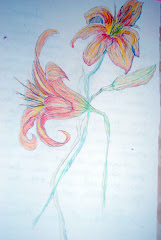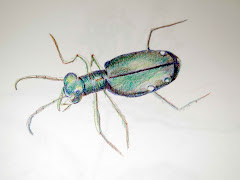




I went out on an adventure yesterday morning: my friend, and fellow naturalist, Jackie D.
http://saratogawoodswaters.blogspot.com invited me to join her, and her friend, Sue P. who is also a fellow blogger.
http://www.watrlily.blogspot.com They were headed out on a hunt for frostweed (Helianthemum canadense) which is a member of the Primrose family; this is a very special plant, indeed. It has large (up to 1 ½ inches long) yellow flowers, that bloom in June; but the “special” part comes in, not when it is in bloom, but rather, in the fall, when frosts start to occur. When temperatures are cold enough, the sap of the plant is drawn up from the roots, the stem splits open, and out pours the sap, in vapor form, which instantly freezes into a solid when it hits the frosty air! The result is something that looks like a frozen waterfall! It is truly magical and quite ephemeral, for you must come early to see it; and once the sun begins to warm things up, the frozen moisture is gone! We delighted in the frost, which clung to all of the plants around us, creating ice crystals and a dreamy atmosphere. We moved from plant to plant taking in the beauty, which was so magical, yet so fleeting.
As we walked the woods, we found partridgeberry (Mitchella repens) with its round, dark, glossy leaves, and nibbled on its scarlet berries; also, we found wintergreen (Gaultheria procumbens) another evergreen, this one with toothed leaves, and like partridgeberry, it too, has red, edible berries. We also found Canada mayflower (Maianthemum canadense) berries, which Jackie was astute enough to recognize, though all it offered for clues as to its identity was a single, leafless stem bearing three berries!
We also found pipsissewa (Chimaphila umbellata) that is another evergreen plant that has shiny, toothed, wedge-shaped leaves. This plant is a traditional medicinal, and was long used by Native Americans to treat fever and to induce sweating. One of the constituents of this plant is hydroquinones, which has a disinfectant effect on the urinary tract system. European settlers also used the herb for both rheumatism and urinary and kidney problems. It was listed in the Pharmacopoeia of the United States from 1820 to 1916!
Sue led us down a hill toward Mud Pond where she had previously spotted a small flock of Hooded Mergansers (Lophodytes cucullatus) and we were thrilled to find them still in temporary residence. The males had their magnificent crests raised, and the effect was lovely and quite dramatic. As we stood there watching them, a flock of Canada Geese (Branta canadensis) flew overhead, and we thought sure they were coming in for a landing, but perhaps the wind was wrong, for they kept going.
While making our way back through the woods, we were intrigued by a sound that we couldn’t quite identify; I suggested that it might be wild turkey, but we couldn’t be certain. While Jackie and I lingered behind, with various things that caught our interest, Sue found the source of the “singing”: a tall Pitch Pine groaned and squealed. As the tree gently swayed in the wind, one limb hung over the limb of the white pine that stood beside it, each time it leaned in, a scratching, moaning sound was made, and as it pulled away, it produced a different pitch. As the wind moved at different rhythms, each note was of different lengths, and timbre, and tone, quite musical for sure, but also organic, and “alive”, like the singing of whales, or howling of wolves. As we listened, Sue moved in and placed her ear against the trunk, and I followed suit, only to discover that the sound reverberated through the entire tree, sending tiny shivers down the spine of the listener.
All of the elements of the morning worked together to create an overwhelming sense of gratitude: for the beauty that surrounded us; the spontaneity; the fleeting quality of life’s experiences, and the company of good friends!

























































